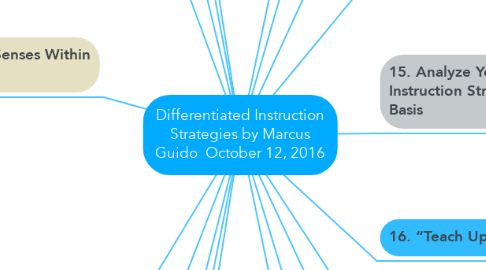
1. 8. Implement Reflection and Goal-Setting Exercises
1.1. • Have students reflect on important lessons and set goals for further learning at pre-determined points of the year.
1.1.1. o Ask students to write about their favorite topics, as well as the most interesting concepts and information they’ve learned.
2. 1. Create Learning Stations
2.1. a. Watching a video
2.2. b. Creating artwork
2.3. c. Reading an article
2.4. d. Completing puzzles
2.5. e. Listening to you teach
3. 2. Use Task Cards
3.1. 1. Make or identify tasks and questions
3.2. 2.Print and laminate single task cards
3.3. 3. Set up stations for partner study.
4. 3. Interview Students
4.1. 2. Pair students together to discuss their results and findings.
4.2. A. Asking questions about learning and studying styles
4.2.1. Their favorite types of lessons.
4.2.2. Their favorite in-class activities.
4.2.3. Which projects they’re most proud of.
4.2.4. Which kinds of exercises help them remember key lesson points.
5. 4. Target Different Senses Within Lessons
5.1. a. Playing videos.
5.2. b. Using info-graphics.
5.3. c. Providing audio books.
5.4. d. Getting students to act out a scene.
5.5. e. Incorporating charts and illustrations within texts.
5.6. f. Giving both spoken and written directions to tasks.
5.7. g. Using relevant physical objects, such as money when teaching math skills.
5.8. h. Allotting time for students to create artistic reflections and interpretations of lessons.
6. 5. Share Your Own Strengths and Weaknesses
6.1. a. Talking about your own strengths and weaknesses.
6.2. b. Explain — on a personal level — how you study and review lessons.
7. 6. Use the Think-Pair-Share Strategy
7.1. 1. Ask students to individually think about a given topic or answer a specific question.
7.2. 3. Have each pair share their ideas with the rest of the class, and open the floor for further discussion.
8. 7. Make Time for Journaling
8.1. A. When possible at the end of class, give students a chance to make a journal entry by:
8.1.1. • Summarizing key points they’ve learned.
8.1.2. • Attempting to answer or make sense of lingering questions.
8.1.3. • Explaining how they can use the lessons in real-life scenarios.
8.1.4. • Illustrating new concepts, which can be especially helpful for data-focused math lessons.
9. 9. Run Literature Circles
9.1. • Helps auditory and participatory learners retain more information.
10. 10. Offer Different Types of Free Study Time
10.1. • Provide audio books, which play material relevant to your lessons.
10.2. • Create a station for challenging group games that teach skills involved in the curriculum.
10.3. • Maintain a designated quiet space for students to take notes and complete work.
10.4. • Allow students to work in groups while taking notes and completing work, away from the quiet space.
11. 11. Group Students with Similar Learning Styles
11.1. Grouping students based on similar learning style can encourage collaboration through common work and thinking practices.
12. 12. Give Different Sets of Reading Comprehension Activities
12.1. • Participating in more literature circles
12.2. • Delivering a presentation
12.3. • Writing a traditional report
12.4. • Creating visual art to illustrate key events
12.5. • Creating and performing a monologue as a main character or figure
13. 13. Assign Open-Ended Projects
13.1. • Work and learn at their own paces
13.2. • Engage actively with content they must understand
13.3. • Demonstrate their knowledge as effectively as possible
14. 14. Encourage Students to Propose Ideas for Their Projects
14.1. Tell the student to refine the idea until it meet your standards.
15. 15. Analyze Your Differentiated Instruction Strategy on a Regular Basis
15.1. • Analyze your strategy by reflecting on:
15.1.1. o Content — Are you using diverse materials and teaching methods in class?
15.1.2. o Processes — Are you providing solo, small-group and large-group activities that best allow different learners to absorb your content?
15.1.3. o Products — Are you letting and helping students demonstrate their understanding of content in a variety of ways on tests, projects and assignments?
16. 16. “Teach Up”
16.1. Helps you bring each student up to “high-end curriculum and expectations.”
17. 17. Use Math EdTech that Adjusts Itself to Each Student
17.1. Educational math video games can deliver differentiated content, while providing unique ways to process it.
18. 18. Relate Math to Personal Interests and Everyday Examples
18.1. Clearly linking math to personal interests and real-world examples can help some learners understand key concepts.
19. 19. Play a Math-Focused Version of Tic-Tac-Toe
19.1. Help students practice different math skills by playing a game that’s a take on tic-tac-toe.
19.1.1. For example:
19.1.2. “Complete question X in page Y of your textbook”
19.1.3. “Draw a picture to show how to add fraction X and fraction Y”
19.1.4. “Describe a real-life situation in which you would use cross-multiplication, providing an example and solution”
20. 20. Create Learning Stations, without Mandatory Rotations
20.1. Set up unique learning stations across your classrooms, but forgoing mandatory rotations.
20.1.1. Create three stations to solve similar mathematical problems using either: • Data — Provide spreadsheets, requiring students to manipulate data through trial and error. • People — Group students into pairs or triads to tackle a range of problems. together, supporting each other’s learning • Things — Offer a hands-on option by giving each student objects to use when solving questions.

